|
Fun and Games
The Battle of the Fulda Gap was probably the
most heavily war gamed scenario of any battle in any war. How to
fight and win a tank battle in a maneuver box roughly eighty miles
wide by two hundred miles long? You are out numbered by a factor of
5.5 to 1. The opponent has capable equipment, sound judgment and
enormous mass; you have better equipment and more skilled soldiers
plus the traditional advantages of the defender, shorter lines of
supply, knowledge of terrain and ability to shape the battlefield.
Success depends on whether the Dutch, German, British and American
forces, sharing very little common equipment or language can prevent
the Soviets from shattering NATO in the main battle area and then
breaking out into Germany west of Frankfurt. At the western end of
the box was the Rhine River and France, at the opposite end was the
east - west German border, the region just northeast of Fulda. The
geographically correct name for the corridor entry point would have
been the Eisenach - Bad Hersfeld Gap. Bad Kissingen and Daley
barracks usually is included in the southeastern corner of the map
box. At stake is the future of Europe, this was the largest battle
ever visualized that never happened.
How to train for this
possibility? How to even begin to visualize the size and scope of
the battle, to test your plans, tactics, equipment against the
weather and terrain with any sort of validity? Questions that have
haunted the minds of leaders and commanders from 1951 to 1991.
Beyond command discussions and CPXs, a new approach based on an old
idea began to address this issue in the 1970s. It was a child's
pursuit tailored to a high stakes question. It was the stuff of
generals and armchair generals.
Thousands of unknown
troopers have maneuvered everything from individual tank counters
across foam rubber terrain boards to divisions in collision as
modeled by super fast computers trying to account for hundreds of
variable factors influencing the first minute of the First Battle of
the Next War. From 1978 to 1991, if you were at Fort Leavenworth or
the Army War College for more than a week, you probably could have
participated in, helped to develop, modify or critique a simulation
event or written an after action report on yet another iteration of
a training simulation of the Battle of the Fulda Gap,
Seventeen year old kids
have achieved complete Soviet victory in less than two hours of
scaled maneuver, seventy year old men have brilliantly commanded the
Eaglehorse through a series of delaying actions and spoiling attacks
to thoroughly frustrate the Soviet attack. For about twenty
dollars, you can simulate the battle with a nicely detailed board
game thirty years old. For a few more dollars, you can fight the
battle on your PC and endlessly experiment with whether the 2/11 ACR
GDP positions would have survived the first five minutes of Soviet
assault. The PC based computer game, available on E Bay, is
amazingly more sophisticated than the first computer assisted
simulation that the Army brought to Daley Barracks in 1978 to drive
an Eaglehorse CPX training event.
Millions of dollars and
thousands of both military and civilian personnel are allocated to
constantly refining simulation events to support the needs
of current Army training. Along with the arrival of the digital
battlefield, the importance of simulation based training is probably
the single largest leap forward in Army training methods in fifty
years. We present a series of brief articles that survey game and
computer simulations from both the active Army and hobbyist
perspective. As always, we seek to find the Eaglehorse on the
terrain board, on the game board and on the computer screen. Ever
want to command the Eaglehorse, run the Regiment or try your skill
as the V Corps Commander circa 1985?
Here's your chance.
Kriegspiel and the US Cavalry, 1914
CAMMS Event, Daley Barracks, 1978
Where's My Beer, Where's my Battalion? Strategy and Tactics 1980
RAM Power and
Warp Speed, the Future Now
The Lead Soviet Regiment has been Destroyed at Bad Neustadt
Tank Combat PC Based Simulations
Hot off the Press
Chess, dating from the 1st
Century AD, is one of the earliest battle simulations archeologists
have uncovered. The origins of the game are in both China and
India. Other games using miniatures and rules of engagement appear
across Europe in the 18th Century and as the Industrial Age opened,
the German military pioneered a recognizable combat war game aptly
named Kriegspiel, as the study of the art and science of warfare
began to merge. The game was added to the training program of the
Army War College in Washington DC at the end of the 19th Century.
The United States Navy also played a significant role in developing
wargaming and simulations in miniature to train officers at their
War College in Newport Rhode Island during this same period.
| |
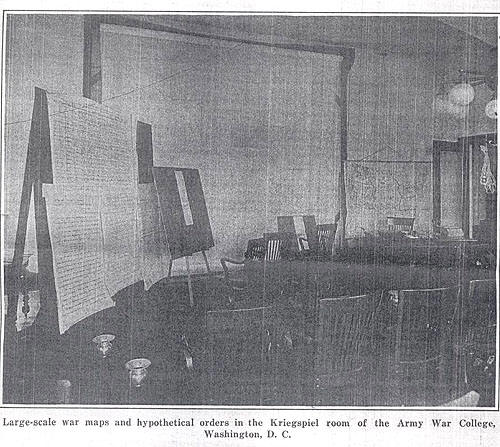 |
|
| |
An officer at the map table during a
Kriegspiel exercise, 1914. Scientific American |
|
The magazine,
Scientific American, followed the opening weeks and months
of the First World War with nothing short of rapt enthusiasm
for the new technologies. Upwards of 40% of each issue was
devoted to discussion of weapons and tactics of the "grand
war"; the reporting is amazing detailed and almost
completely devoid of any mention of casualties or death.
All of Europe at war was a grand spectacle and airplanes,
submarines, vast forts and huge cannon seemed to have
sprung from the pages of "futurist-novelists" . One
magazine issue featured a three page fold - out to show the
reader the actual diameter of a massive German artillery
shell. The Plains Wars of the 1870s and the Spanish
American War had faded from the American conciseness and all
of this war technology was very new, very exciting and very
far away.
The 5 December 1914 issue
of Scientific American contained a detailed account of the American
version of Kriegspiel as adopted by the Army. The following blocks
of text borrowed from the longer article indicate that the Army was
ready to explore the innovative training device but slow to grasp
the realities of the opening days of the First World War.
"The Red and Blue force
student commanders briefly see the main, fully detailed battle map,
established at a scale of six to twelve inches per mile depending on
the type of scenario being studied. The commanders and staffs then
leave the main room to follow the battle with their field maps,
draft their plan and brief subordinates. Umpires and other student
officers actually maneuver the pieces on the map."
"For locating the
positions of the various troops in the exercise or placing them
rapidly, a very ingenious system has been devised by our officers.
For instance, when it is desired to show a long column in march, the
various elements of the command are represented by oblong strips of
cardboard, cut exactly to scale, a distinctive color or combination
of colors for each branch of service, pinned one behind the other on
a long strip of wood, which when laid on the map intact, covering
exactly the proper distance. When it is necessary to deploy, to form
line to the front, the sections are taken from the strip, one by one
and pinned to the map in their order of reaching the line. "
"A deployed line or line
of skirmishers, is represented by small beads, strung on wires which
may be bent in any shape to conform to the condition of the ground
on which they are supposed to occupy. Individual pieces of
artillery are indicated by single red headed pins; a battery by a
crimson strip of cardboard."
| |
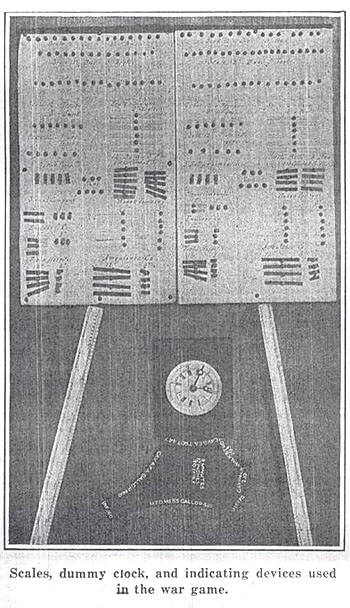 |
|
| |
Somewhat indistinct in the scan, the
top is the storage area for various cardboard strips and counters
used to represent units on the map board during Kriegspiel. Then,
the special game clock and below, a gauge with various scaled
templates to plot distant over time for cavalry, infantry and wagon
movements. Scientific American |
|
The article then
recounts the actions of a horse cavalry rear guard problem
as studied in the simulation. Captain Blank is the Blue
force Commander trying to delay a fresh Red attack on an
infantry division with his depleted cavalry units.
"He looks at his map,
eagerly scanning the winding contours which mark the hills and
valleys, and quickly settles on a nearby wooded crest to make his
first stand. Then he issues his orders, writing them out for the
umpires, although under service conditions they would probably be
oral, with a decided snap to them. His time scale, cavalry at a
gallop, shows him that the position, one half mile away may be
reached in two minutes, and the yellow headed pins gallop to the
designated high point, under the hand of the umpire."
"... all the time the
deployment was in progress (( the pursuing Red force coming under
initial fire from Blank's squadrons and moving into an attack
formation )) Blank's troopers dismounted and his artillery was
pouring fire into them, delaying them further. At about the time
the enemy deployment was complete, Blank's orders were written
again. His battery limbered up and his troopers mounted, one
regiment at a time, and galloped up the road, closing on the main
body, where they took another position, and in a few minutes, the
regiment that had been left behind to act as the guard to the rear
guard, came up and joined them. Blank so far has gained a mile and
one half delay for the infantry."
At any point, the article
continued, the umpires may end the exercise to discuss the major
teaching points that the action had revealed; the discussion was of
equal importance to the actual board play of the problem.
One hundred years after
printing, the article is filled with unintentional irony. The
full account of CPT Blank's cavalry delay problem reads as though
they were wargaming the Battle of the Shenandoha Valley in 1863, not
preparing for the trench warfare, poison gas and machineguns that
defined the combat experience of the American Expeditionary Force
in Europe in 1917. The article speculates that somehow, America
might be drawn into the war and, in the wonderfully ornate language
of the period concludes,
"To a layman, it might
appear ridiculous to watch the seriousness and concentration of an
earnest class of student officers, poring over a map and aimlessly
moving little pins and blocks about it pictured surface. But in the
hand of those men the safety of our country lies, and the state of
our preparedness for war, with our tiny army. Our army now numbers
thousands - these gentlemen play the map game with hundreds of
thousands, what we would require in time of war, and they know that
such a number is necessary - and strive their mightiest to learn
how to hold the enemy in check with our little handful until the
volunteers can be trained, which takes months! May the day of
sacrifice by deferred!!"
| |
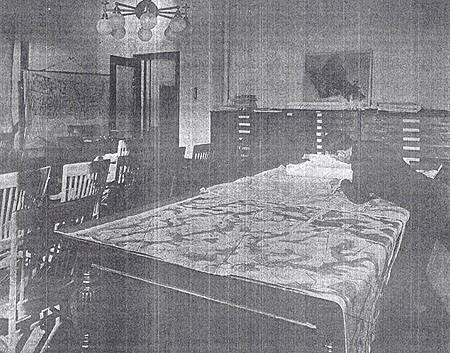 |
|
| |
An officer at the map table during a
Kriegspiel exercise, 1914. Scientific American |
|
On the same page
that the article ended, a two paragraph feature noted that
with England and Germany now at war, hundreds of English
language teaching positions had opened in Germany and any
American with an interest and the skills could easily find
employment.
With only minor changes,
Kriegspiel continued in use with the Army as the principle map based
force on force training simulation for officers through World War
II. The Museum of the Naval War College at Newport has an excellent
display covering the development of wargaming as applied to the
Fleet. Due to security concerns, the museum is currently open by
appointment only.
On the Internet, there are
a number of very good histories of the origins of wargaming and
developments in both the United States and elsewhere through the
19th and 20th centuries. A very detailed yet readable account can
be found at this link:
http://www.hmgs.org/history.htm
Although the men of the
2/14 ACR had their share of CPXs, map exercises, terrain " walk and
talks " and sand table exercises, modern war gaming or the more
correct, digital simulations with variable outcomes, was not
introduced to the armored cavalry until in the Summer of 1977. A
training team from the 75th Maneuver Area Command was passing
through VII Army in Germany with a computer and terrain board combat
simulation called CAMMS, Computer Assisted Map Maneuver System. For
the Blackhorse, the first exposure to this new training device was
at Downs Barracks, understandably it war gamed a potential Soviet
attack through the Fulda Gap
| |
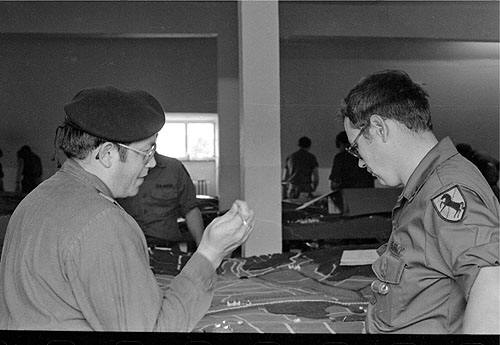 |
|
| |
SSG Badal, in threat uniform, and SSG
Stafford consider a problem on the board. --Rick Badal
|
|
CAMMS, aimed at
exercising the battle staff and decision making capabilities
at the battalion / squadron – brigade / regiment level,
featured a gymnasium full of molded foam terrain board
sections pieced together roughly resembling Germany. Over
the hills and through the fields, controlled by the Lts and
Platoon Sergeants, plastic pieces at the section and platoon
level were maneuvered in battle with Soviet counterparts
controlled by members of the S2 / R2 staff. At this level,
it certainly was very similar to the cavalry Kriegspiel
exercise of CPT Blank. On the handstands, in the M577s,
commanders and staff worked to understand the battle as
reported by the platoon leaders and issue the appropriate
FRAGOs and Operations Orders.
Unit movements and the
results of direct and indirect fire were unsorted by a bank of early
model personal computers networked to a portable mainframe all of
which were operated by the CAMMS support staff. The following year,
CAMMS came to Daley Barracks as the simulation was fine tuned to
support a squadron level tactical scenario.
Bob Stefanowicz
As I recall, the CAMMS
training team passed through on a yearly cycle, and for many of us,
it was our first exposure to PCs in use at anything other than the
Math Lab level. The simulation was a command and staff event, I
directly participated only one year, during the subsequent visits, I
was on the secondary staff or a Troop XO and therefore, exempt from
the sim. I think the exercise ran for three 12 hour days, each game
phase to include movements and resolving the combat took between
thirty to forty-five minutes.
| |
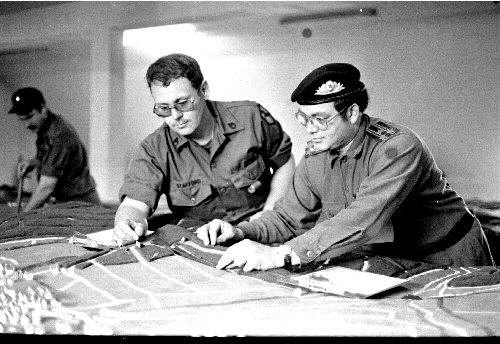 |
|
| |
Another great view of the proceedings
at the terrain boards. Anyone recognize the guy with the broom?
--Rick Badal |
|
The Soviet forces
were controlled by personnel from the Eaglehorse S2 shop and
they mimicked threat tactics and doctrine. The simulation
fairly accurately depicted our basic nine map sheet group,
somehow, the portable foam terrain board sections had been
configured to match our maps and there was an agreed upon
initial scenario of an attack with the squadron fighting a
delaying action. I had only completed the Armor Officer's
Basic Course a few months earlier and we had encountered
nothing like this.
I am pretty sure the
first year, we used land lines rather than FM to communicate to the
TOC and one or two platoon leaders or platoon sergeants were
responsible for the company / troop counters on the board. On the
second visit of the team, I vaguely recall discussion of special low
power FM frequencies being allocated to the simulation. Everything
was assembled in the gym at Daley; there was a system of filling out
slips of paper indicating who was moving where and with what intent,
these were given to the CAMMS support staff who then ran the data
into the computers and waited for the printers to spin out the
results of the fight. In terms of portability, this was the day
when a portable mainframe would just barely fit in a 35 foot "pup"
semi trailer.
The computer actually
counted off each tank or PC as it was destroyed or disabled; there
may have even been a % of combat effectiveness factor tallied after
each phase. For the platoon leaders and key NCOs, the level of
sophistication of the sim at the terrain board level left a lot to
be desired in terms of what you actually learned. Tanks in a
prepared battle position could be destroyed in a matter of minutes
at long range, a recon section caught in the open at close range
might escape unharmed. Cotton balls laid in a line represented
obscuring smoke, you could use this on the maneuver board but the
mainframe did not have an algorithm to factor the smoke effects on
visibility in combat. I think combat results during "darkness" were
first figured as daylight engagements then, the results were reduced
by 45%. As said, it was primitive but it was a start.
| |
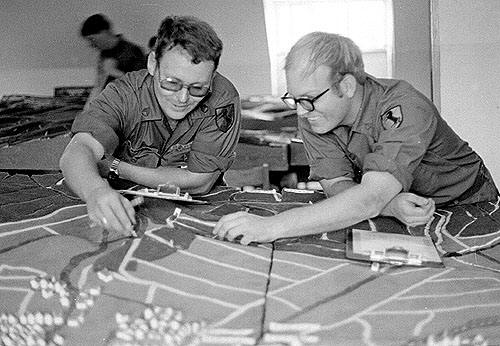 |
|
| |
SSG Stafford and unknown Eaglehorse
trooper during CAMMS event at Daley, 1979. The image shows the foam
terrain boards and the ever present clip boards used to carry
movement data back to the training staff for input into the
computer. --Rick Badal |
|
Having said this,
the real benefit of the event was to generate the reports
and information necessary to drive the planning and decision
making process of the CPX. I imagine the guys in the S3
shop and the CP were kept rather busy.
Looking back, the software
and computer logic certainly had limitations but the experience was
an interesting diversion and at the time, I do not believe that any
of us imagined just how sophisticated and important simulations of
this nature would become in future training and battle planning.
CAMMS existed in refined forms well into the mid 1980s. At Fort
Leavenworth, as computers with greater memory and faster processors
became available, the Army devoted considerable effort to devise
more realistic simulations and computer assisted events to assist
training at all levels.
To learn more about CAMMS
and the interesting history of the 75 Maneuver Training Command,
follow these links:
http://www.globalsecurity.org/military/agency/army/75d.htm
http://64.233.161.104/
Robert Stefanowicz
The visit of the CAMMS
team did not fully satisfy the war gaming instincts of some of the
officers at Daley Barracks during that period. In retrospect, this
may have at least partly been because you could not rest an open can
of beer on the CAMMS terrain boards!
The mid 1970s through mid
1980s period represented what is now recalled as the " golden age "
of table top war gaming designed for the consumer market. Many of
the officers coming on to active duty in that period had played the
games of the major manufacturers, Avalon Hill, Strategy & Tactics
and SPI while in school. The Army developed small unit simulation,
Dunn - Kempf was not part of Armor Officer training but cadets from
both the Military Academy and ROTC usually recall there were
several copies to " goof around " with; exposure to table top gaming
was very common. At both the Border Camp and the BOQ, someone
always seemed to have a copy of Gettysburg Day 3, Panzer Blitz or
Pike and Archer in their briefcase just in case once the duty day
was done, someone wanted to roll the dice and start the bloodshed.
Some of the NCOs were involved in this also.
| |
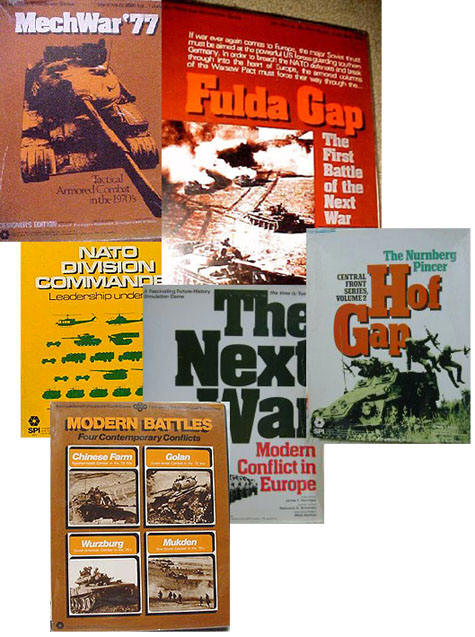 |
|
| |
A composite image of box art of various
1970s games modeling "modern" combat in Germany.
|
|
The games from
that era were more sophisticated than you might imagine,
this was both their strength and weakness. I recall that by
1985, there were over two hundred titles, the average retail
was low, maybe $8.00 and you could explore history and
warfare from the Crusades well into the future with fantasy
gaming series such as Battle for Mars. There were clubs,
magazines and conventions devoted to the hobby.
Regardless of the
publisher, the games followed a basic similar framework. The map
board was a very good but not absolutely accurate depiction of the
actual terrain. Even now, the game map sheets I have retained that
show the Bad Kissingen - Fulda - Wurzburg - Hof region are more than
passable for recalling locations of the major cities and towns.
Having said this, the maps were not as detailed as a 1/50 000 scale
military map. There were no contour lines, small towns and villages
were left out if the population was under 10 , 000 people. The
major wooded areas, rough terrain, swamps were retained.
Overlaid onto the map was
the hex shaped system which, like a more complicated version of a
chess board grid, provided the basic organizational framework. The
units, depending on the game being played, could be battalion sized,
company / troop down to squad or single armored fighting vehicle.
The designers took great care and were justifiably proud of the
level of accuracy they rendered in the order of battle. The "
modern " games in my attic are a quick reference for what were the
combat battalions in the V Corps. Likewise, the Soviet forces were
modeled as accurately as a civilian game designer might be able to
determine from the period, unclassified sources.
| |
 |
|
| |
A composite image of box art of various
1970s games modeling "modern" combat in Germany.
|
|
The actual play of
the game allowed for one player to move then resolve combat,
followed by the same sequence for the opponent. Each
company, troop or battalion, represented by a counter on
the map, had certain strengths and weakness that reflected
the true capabilities of the actual unit. A mech infantry
company counter had very good " through woods " movement
capability, much superior to a tank company, but pair the
two in a fight on open terrain and it's see' ya mech! Allow
the mech unit to set up a prepared position in a city and
attack with the tank company and it's quite another story.
The results might be further skewed by whether a unit had
recently been resupplied, subjected to NBC attack or had
previously been reduced in strength by earlier combat
losses.
For anyone with an
interest in military history, the games allowed you to recreate a
historical event perhaps hundreds of years old and bring it to life
as no history book could. The results might not always follow what
actually occurred on the battlefield. A hidden value of the S & T
published games was the rule book often contained a wealth of
writing from prominent historians recalling the events and
circumstances of the actual battle or campaign simulated in the
game.
| |
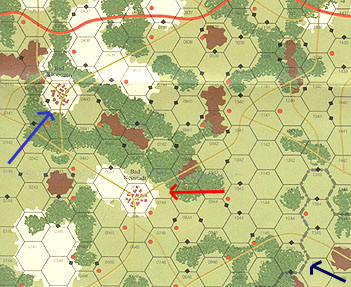 |
|
| |
Map detail showing Bad Kissingen, blue,
Bad Neustadt, red and border, black arrow. During the play of the
game, not much goes on in this corner but it is fun to see the area
recalled. |
|
Some of this can
be difficult to explain unless you have at least some
limited background in gaming. In terms of modeling
battles, the devil is in the details. For example, in a
battle everyone recalls, Custer's 7th Cav must be very
skillfully maneuvered along the Greasy Grass River game
board to " win " Custer and the Sioux; winning is
determined as surviving long enough for Reno and Benteen's
columns to attempt a rescue. The game pieces available to
the two players accurately represent what was on the field
for the actual event, they move or fight with the relative
ability of their actual historical antecedents. If you play
the game exactly as Custer commanded, you will lose 100% of
the time. The Lakota Sioux held all the cards in 1876 and in
the " modern " game, they hold most of the cards again. On
your table top or on the field of battle, skill is
important, luck is important. I read that even among the
most dedicated players, Custer loses about 75% of the time,
but every now and then, he salvages his command at the last
minute, here's a partial game hint, if CPT Benteen rides his
horses into the ground trying to reach Custer ...
The war games of that
1970s and 1980s period were certainly more than games of chance,
they were closer to simulations with several accurate possibilities
modeled. The more detailed games became so complicated in the
interest of realism and accuracy that even Lts and NCOs with a very
good knowledge of the tactics and terms, could easily become lost in
the rules. The 11th ACR was a featured unit in many of the games
that modeled war in Germany, the unit prominently appears in: Fulda
Gap, Fifth Corps and Division Commander. Of particular interest to
members of the Eaglehorse, the S & T game Fifth Corps: Soviet
Breakthrough at Fulda, published in Sept - Oct 1980 featured the
2/11 down to the troop level and the game map is very familiar to
any veteran of the unit in Germany.
| |
 |
|
| |
Here's were the cardboard carnage
occurs, Fulda and just above and to left, the cork in the bottle,
Schluctern. |
|
In this game, you
are playing the Fulda Gap scenario of a Soviet attack
targeting Frankfurt. Bad Kissingen, Fulda and Bad Hersfeld
appear on the eastern 1/3 rd of the map sheet. The
individual unit "counters" are at the company and battalion
level with most of the Corps represented. All of the combat
units of the 11th ACR are present as Troop level counters.
There are no markers for the individual HOW batteries, they
are modeled as a single FA battalion. There are no
counters for the headquarters units, logistics are heavily
modeled into the game but there are no individual counters
to represent the assets. This is a game of maneuver and
combat, with logistics built into the rules but not widely
represented on the map sheet.
The game is controlled by
a "clock" consisting of nine 12 hour blocks or turns. Within each
time block, the Soviet player may move his pieces in the attack, he
is limited by the types of terrain he is on, the types of units he
is moving and their logistic strengths. If a Soviet unit moves into
a hex adjacent to a NATO unit, it must stop until the combat is
resolved. Combat is resolved by a roll of the dice and then
determining results against a rather complicated " combat results
table ". Results vary from complete annihilation to partial loss of
combat power for the units engaged to no loss of power but either
attacker of defender forced to move back one hex. Once the Soviets
move and combat is resolved, the NATO player may move his pieces and
the next round of confrontations is resolved. Once both players
have had their move and combat phase, a single 12 hour block is
completed. Sequenced against the " clock ", various reinforcements
become available at certain turns.
| |
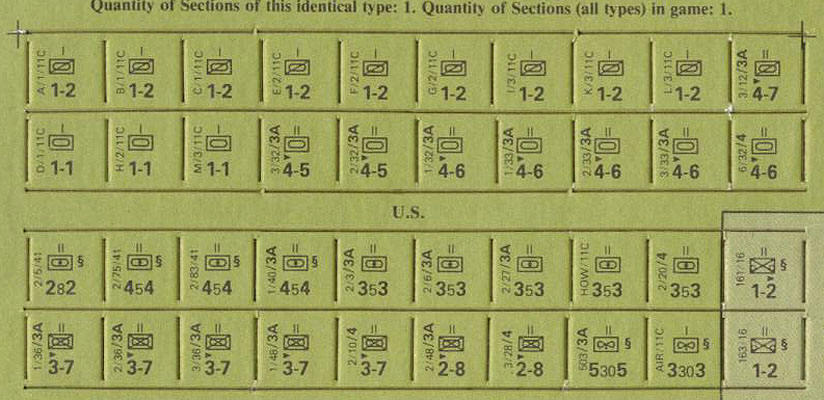 |
|
| |
Unpunched cardboard unit counters
showing what the V Corps commander has at his disposal. The units of
the Blackhorse are found in the right column.
|
|
In many ways, all
this resembles a much refined version of Kriegspiel played
by officers at the War College prior to WW 1, with the
exceptions that there are no umpires and both players, by
being able to see the full map sheet and location of all
units, have the God's Eye View of the battle. If you are a
true enthusiast and attend a convention to play on the
tournament level, the fog or war is introduced by umpires
controlling a master map board while the two opponents play
in separate rooms with only their own forces and enemy
forces in contact visible, the " double blind option ".
What worked in 1900 is still the logical solution one
hundred years later.
As the game progresses,
"victory points" are accumulated by both sides by achieving certain
tactical goals; for the Russians, seizing certain key terrain areas,
destroying specific NATO units and so on. NATO victory points are
accumulated by defending certain areas for specific periods of time
and attriting Soviet tank strength. Very infrequently is the game
decided by a dramatic " sweep from the map of all enemy forces "
usually it is a matter of a few last additional points squeezed out
in the last 12 hour block.
For novice gamers, the
problems arise with a rule book which for this game consists of 17
pages, each page containing three columns of data and information
broken down into paragraphs and sub paragraphs. Just to have a
general familiarization with the game requires a 40 minute careful
read of instructions and rules. Obviously, with more experience,
the lower the learning curve, but as games go, and V Corps was
typical of many, to play required a lot of work; it was detailed and
complicated. Here is the one funny story related to the topic from
my days in the Eaglehorse.
| |
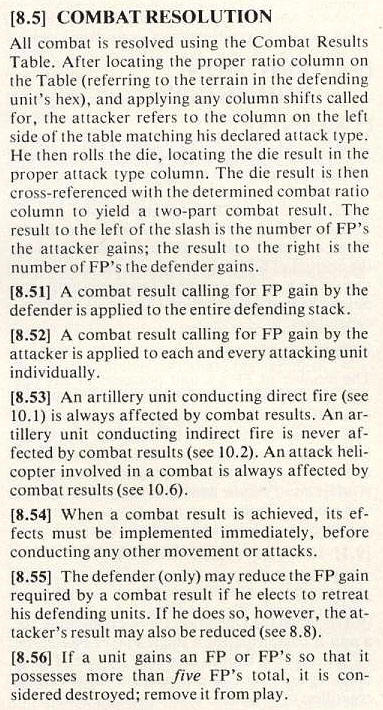 |
|
| |
Just to give you an idea of the rules
and procedures that govern the game, here is an excerpt.
|
|
One Saturday night
in 1980, a group of the usual suspects were at the "group
home" a bunch of other Lts shared. We were casting about
for activities and one of the gamers suggested a simulation
he had just received that he thought would be interesting to
play. The game was called Wurzburg and modeled the 3rd
Infantry Division's defense of the city against a Soviet
attack focused on the Gramschatzer Wald region just east of
town. It was infantry in paradise, fight in the woods-fight
in the city. I think the game was modeled to the company
level and the map detail was astounding, particularly when
compared to our military maps. The US player won if he
successfully bogged the Soviets down for nine game turns,
Sovs won by pushing the US out of the woods and then taking
all or most of Wurzburg.
About ten minutes into the
public reading of the rules, one of the Lts who later went on to a
very full career to include command at several levels announced in
command voice with eyebrows arched, " Well! I have another idea.
Lets play a game involving cards ... and involving poker chips ...
and involving beer! And if we can't find the cards or the poker
chips ... well that's OK to!! " Needless to say, the usual suspects
indulged in the usual activity.
| |
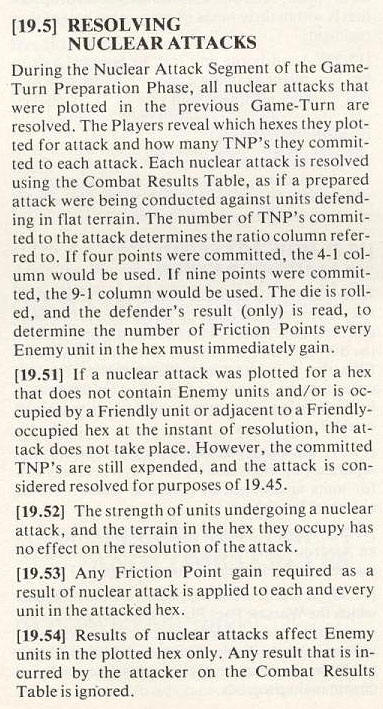 |
|
| |
... and the sub paragraphs discussing
nuclear weapons. Like golf, some work must go in prior to finding
the enjoyment of the game. |
|
There are any
number of good web sites devoted to table top war gaming, a
good place to start is this site, just explore unitl you
find the niche you are looking for:
http://www.boardgamegeek.com/
Army Simulation
Supported Training - Thirty Years in Ten Minutes
Robert Snedden LTC (Ret)
What does the commander
want to achieve? Simulation support training is based on the same
two things as every other training event-the training audience and
the training objectives.
A model is an
approximation of reality. A simulation is a model run over time.
The simulation is the
training aid, not the training.
May, 1975. Kriegspiel
to Dunn-Kempf
Young officers in combat
units participated in tactical war games played out on scaled
terrain board using miniature vehicle models and dice rolls to
adjudicate conflicts. Red and Blue moved pieces, rolled the dice,
removed the losers and then considered their movements for the next
turn. This was not much different from what you could buy in a
local hobby store. Umpires unsorted disputes, enforced artificial
terrain and obstacle effects and generally made the participants
play nice. Weapons effects (probabilities of hits and kills), fire
support, logistics, air support, intelligence and environmental
effects were nonexistent. "Real time" and the fog of war were also
missing. The US Army was doing business the way the Imperial
Japanese Navy war gamed the battle of Midway in the '30s and the
German High Command looked at Channel invasion scenarios in the
'40s. It's just that not much funding and development had been
devoted to simulation development during Vietnam. It took a while
to get the wheels moving and for technology to be adapted to our
needs.
May, 1978. CAMMS and
CAMMS Evolution
Young officers in combat
units participated in tactical war games played out on scaled
terrain board using miniature vehicle models and a machine called a
computer to adjudicate conflicts. In reality, the computer was
closer to a high end calculator but it kept the random dice rolls
out of sight and it did attempt to factor in pH and pK, possibility
of a hit and possibility of a kill. The other limitations were
still there but at least a starting developmental framework was
found.
May, 1984. Corps staff
personnel participated in CPXs that used a computer to model Red and
Blue combat operations. A group of role players huddled around DOS
based input terminals ready to call information back to the corps
staff in the various CPs. It took days to feed the STARTEX data
into the computer, logistics was largely ignored, weather effects
and terrain were rudimentary at best, the staff had little chance to
influence operations in real time but the electronic battlefield had
arrived. A hybrid of several "stove-pipe" models had been cobbled
together to produce combat operations information for staff
training.
Times, they were
a-changing and Fort Leavenworth devoted ever more resources to
exploring computer driven simulations. Real computers and
interactive simulation models were on the way and the virtual
battlefield was beginning to emerge. Bulky, temperamental and
incredibly limited by today's standards, these early machines could
consider weapons effects, weather, line-of-sight, terrain effects
and obstacles as they applied algorithms to tactical operations.
Platoon and company level simulation models such as ARTBASS and
JANUS eliminated the game turn by introducing dynamic real-time
interaction. Battlefield awareness, risk assessment and timely
decision making started to mean something.
Corps Battle Simulation
(CBS) and Brigade and Battalion Simulation (BBS) 1990.
Building on what was
learned and ever more capable hardware, the Army began to make
simulation supported multi-echelon training a reality. These early
legacy simulation models were limited by computer capacity, modeling
effects and operator expertise. Work stations were DOS based input
terminals coupled with raster map images projected on separate
monitors. Simulation development tended to focus on combat unit
training requirements, e.g., force-on-force, fire support, air
defense, air support, chemical operations and the like. Logistics,
medical support, maintenance activities, vertical and horizontal
engineering and CSS, combat service support, unit activities in
general were glossed over or not included in the models.
As an aside, this "tooth
driven development" continues in part today. Efforts to develop CSS
oriented simulations have resulted in a number of largely
incompatible models developed in isolation and problematic to run in
confederation. In other words, logistics simulations modeled for
training transport battalions did not necessarily work well with a
medical logistics computer model and nothing matched entirely with a
Corps level logistics model. The goal is to have all Army
simulations seamlessly fit together and totally interactive; we
have made good progress with the combat sims, the support and
logistics simulations have yet to be fully integrated. A good deal
of effort in the last ten years has been devoted to rein in the
chaotic development process and control funding to produce a limited
family of simulations that will support total Army training
requirements. We were fighting the old battle of getting everyone
in the simulation business to speak the same language, use the
same parameters, use the same rules.
Strategic deployments and
tactical employment began changing in the early 1990s as the
simulations evolved to match the current threat. The Contemporary
Operating Environment (COE) replaced the conventional Warsaw Pact
threat and the Fulda Gap. COE postulated an asymmetrical
battlefield populated by a bewildering mix of conventionally trained
forces, partisan activities, local militia, criminal bands and
individual nutcases. Improved C2, command and control, systems were
being fielded. Offense and defense gave way to raids, sweeps,
patrols, searches and other aspects of Security and Stability
Operations (SASO). Form followed function and US Army training
support requirements changed to meet the new tactical environment.
Simulations began to incorporate aspects of the non-linear
battlefield and the presence of digital C2 in units. Two sided
scenarios (Blue versus Red) were being replaced by multi-sided
forces on the simulation battlefield. Technology was being used to
network virtual trainers into Synthetic Theater of War (STOW).
Synthetic Theater of
War: STOW
By 1998, Windows operating
systems and point-and-click menus were replacing the DOS menu
screens and commercial off the shelf (COTS) products were replacing
proprietary hardware and software. Digital terrain and larger zones
of conflict (play boxes) were being added. Improved CSS
requirements (expenditures, maintenance, medical evacuation and
treatment, etc.) had been fully incorporated and were being improved
with every version.
Simulation development
addressed training needs at all levels, starting with the individual
soldier. Increasing training demands required a hierarchy of
simulations, each with capabilities and limitations and each
designed to support selected training audiences. Databases for high
resolution entity based models such as JANUS, JCATS and the neophyte
OneSAF can portray tactical activities at the individual level
(soldiers, vehicles, weapons systems, sensors, communications
devices, etc.). Aggregate simulation databases such as BBS and CBS
are used to support staff training exercises and are generally used
portray the "normative" unit size (squad, platoon, etc.) being
tracked by the primary training audience.
It's almost 2005 and as
computers have improved, so has the ability to replicate the myriad
military activities faced by the current generation of warriors.
Graphical user interface (GUI) has improved, making it easier to run
the simulation and keep it from detracting from training. Software
exists that more closely approximates "ground truth". Simulation
stimulation of digital C4I (colloquially known as Run Time
Manager-RTM) is a reality.
Sophisticated simulation
models interfaced with digital C2 and running on complex networks
requires dedicated Battle Simulation Centers (BSCs) with the
appropriate technical support. All Active Duty installations and
many Reserve and National Guard posts now have a BSC. FORCOM has a
program that utilizes Battle Projection Centers (BPCs) to provide
distributed simulation supported training to Reserve Component units
throughout the US. Some Active Duty posts now have Battle Command
Training Centers (BCTC) with the capability to provide full
integration of the Live, Virtual and Constructive (L-V-C) training
venues. Technical expertise at these BSC's and BPC's is provided by
full time civilian contractors. Since my retirement from active
duty, I have been involved with the staffing of these training
venues as a civilian contractor.
Operational requirements
have resulted in highly detailed interactive simulations that can
support multi-sided training events that include traditional combat
operations as well as digital C2 stimulation, urban operations,
insurgents, civilian riots and a host of other combat, combat
support and combat service support activities. Having said all
this, however, an interesting lesson can be learned from the current
situation in Iraq. If your simulation is sufficiently detailed, you
can model and present as a training environment any of hundreds of
variable scenarios. For the training to be truly useful to the
troops, the variables must match the realities the soldiers face on
the ground.
It is most assuredly not
your father's Oldsmobile anymore, the Fulda Gap may have disappeared
as an active simulation model for commanders, however, if required,
the scenario could be quickly resurrected, updated and integrated
into the most advanced simulation programs. Having trained with
CAMMS as a the H Company commander in 1978 and now professionally
involved with simulation support for the active and reserve force,
the level of change and sophistication is amazing. In 1978, we were
horse and buggy, today, we are as robust as a Humvee and faster than
a 2005 Porsche
Cars that start with a
hand crank are all well and good, museum pieces for sunny Sunday
afternoons but not really daily drivers. This also applies to
combat games, why worry about all those cardboard counters marching
across a paper map when the digital age has arrived!
What follows is provided
by the game designers of HPS and it shows just how far things have
come. They have created a series of PC based games that very
closely follow the board games of the 1980s except much has been
upgraded and simplified. Among their creations, and currently
available to the public, is a fully developed Fulda Gap game that
includes the Eaglehorse squadron. I asked them to create a scenario
that focused just on the old squadron area and it was included in
their presentation. The actual expansion pack necessary to play the
Meiningen Gap variation will be made available by HPS shortly. So
while the kids in your house may settle down on Christmas Day with
Bloodstorm for PS2, (certainly in keeping with the Season!) how
about treating yourself and that new PC to a game of North German
Plain 85.

Just Remember, F6 Fires
the Coax!
PC based simulations of
NATO vrs. Warsaw Pact forces are, by and large, refined versions of
map board based gaming. The level of sophistication is amazing but
this is simulated combat reminiscent of the dim white interior light
of an M577 as the radios buzz and the counters move across the map
boards. Warfare at the soldier - tank and platoon level is a
distinctly different sub set of the computer gaming industry.
“ First person shooter “
style games have come to dominate the market, every major developer
has dozens of products available configured for both portable gaming
devices such as Game Boy and desk top PCs. Only a year or two away,
versions of these games will be available for the new generations of
cell phones featuring gaming options.
The look and style of
these games is familiar to anyone who has even casually wandered
through the local Walmart or consumer electronics meglo - mart. On
the screen, you see “ your hand holding the weapon “, using the
controls, you maneuver the character through alley, street and
battlefield, firing whenever the enemy appears. Some games are more
realistic than others, the opponents range from the Wehrmacht to the
Soviets to the Taliban to space invaders; as you blast away, it ’s a
fire fight, a free for all, a gore for all! Kids and young adults
love these games, new titles are always appearing but it’s not quite
“ gunner - SABOT … !!”
A noteworthy and
sophisticated variation of this type game puts the participant in
command of a tank. Game designers have been tinkering with the
format for years with varied results. Two of the more popular
titles, Panzer Commander
and M1 Tank Platoon
II, are on my shelf. Ancient by the
standards that electronic games are judge by, they nevertheless
still offer some entertainment value.
Panzer Commander is dated
and feels it, but it’s fun to choose to be either a Russian, German,
Brit or American and have your tank modeled as a Sherman, Panther or
T 34. The game clatters along, the terrain modeling is cartoon -
like but the tank on tank fights are really pretty good and,
actually learning to operate the sim is a fairly simple process. I
keep an old PC around just to goof off with this game. A few years
later in the developmental cycle and decades forward in the
scenario, M1 TP II provides a “ quick and dirty “ trip down memory
lane if for a minute, you may have forgotten just how difficult it
can be to lead a platoon and fight a tank, even if just in
simulation - in your home for only half an hour before supper.
A great history
and review of PC based tank on tank combat simulations was
recently posted at George R. Bradford’s AFN News web site. “
Pete “ really knows his stuff and the review is a
fascinating insight into the development, strengths and
weaknesses of these consumer oriented simulations that are
several steps above the “ first person blaster “ Nintendo
style games.
“ Pete “ on PC Based
Tank Combat Simulations
I played my share of tank
sims and here's the run-down with info based on my experience and
what I’ve gathered from the gaming magazines and other gamers. Your
best bet if you're unsure, is to run each game by Amazon.com and see
how they rate. I like Amazoners because they can be fairly blunt and
honest. I usually don't buy anything three stars and below. I played
all the below, not anymore though. I bought the below because they
were by far considered REAL TANK SIMS, not action games or arcades.
I played all sims with a joystick...first a simple two-button one
and then Microsoft's ForceFeedback Pro joystick when that came out.
All the below tank sims have artillery.
* M1 Tank Platoon:
This is by far, IMO, the best tank sim ever made but most likely
won't work with Microsoft XP. The graphics are extremely dated
though (EGA), but the physics, AI ( artificial intelligence ),
gameplay, and manual were top-notch. I could've sworn that the enemy
USSR AI kind of had a brain of its own, never attacking from the
same direction or splitting up when not expected. You can really
shoot straight and on the move and M1s seemed to really have the
true first-hit-rate of 90%. Tanks take damage, etc. There is
weather, fighting at night, fog, horizon differences, etc. You can
award medals and crew performance increases (like 120mm reload
times) as your crew survives more missions. Yes, crewmen die. Best
of all, I won many times with just four M1s, two M2A2s, and
artillery against 35 T-80s and BMPs. The enemy AI gives you a good
fair clean fight...hey, these were the 286-386 PC days. The enemy
was literally in red-colored tanks and APCs, but no one really cared
at the time. Thumbs up for this “ oldie but goodie “! Microprose was
the developer.
* iM1A2.
Interactive Magic's (defunct company) iM1A2 also probably won't work
on XP. iM1A2 was a "step-up" from "M1 Tank Platoon" and some
designers of M1TP went to a North Carolina game startup and worked
on iM1A2. The graphics are way better than M1TP (no red enemy
tanks), but the AI not. Most enemy AI would just drive straight for
the objective, no maneuvering whatsoever, and if your driving the
other way, you'll be literally two tank columns passing in the
daylight (if you see them, that is). Even the last enemy AI APC
would just drive to the obj (usually a hill) and just sit there
waiting for you to come by and kill it. With like 100 hills in a
map, it'll take a long time to find that lonely enemy APC and kill
it to end the game if you drove off somewhere! So, yup, the game
boiled down to drive somewhere else, wait for about thirty minutes,
find a far hill overlooking the obj, and then fire away! If you sat
on the obj waiting for the enemy to come, you'll be shredded due to
sheer USSR numbers.
The game physics were
pretty watered down from M1TP with shots often missing unless you
were stopped or at a crawl. This game had NO effect on crewmen
performance (believe me, the flat-rate 120mm reload time could be
pretty annoying). The platoon AI was okay, but the enemy AI sure
stinked. I think there were only one A-10 and SU-25 and they almost
always got shot down quickly because the game designers wanted you
to do the most tank-killing work, not CAS. Thumbs down (unless you
can get it cheap)!
* M1 Tank Platoon 2:
Microprose went "belly-up" and was bought over by Hasbro (yes, the
Mr. Potato Head maker ). M1TP2 was an attempt to revive the glory
days of M1TP...oh...after five years elapsed. Hasbro cobbled up what
was left of the M1TP team (but like all winning Super Bowl, NBA
Champs, and World Series teams, the M1TP team scattered to the four
winds). The fact is, M1TP2 had a lot of hype with awesome 3D
graphics: AH-1s, USMC LAVs, troops that moved, A-10s, AH-64s, AAV7s,
Humvees, etc. The problem is, M1TP2 WAS NEVER COMPLETED! THE GAME
WAS SHIPPED 80 -85% DEVELOPED --- BUGS AND ALL were packaged up and
sent to retail! Hasbro knew this...they sold it anyway and boy did
that piss off the M1TP2 players! Worse of all, Hasbro offered no
patches or additional versions!
I played it and to say it
wasn't complete was putting it lightly. For instance, say your
Humvee scouts spot the enemy tank column (USSR again even though the
Cold War ended) 3,000m away on the overhead map at the bottom right
corner of your screen. You're on the top left corner. OK, so you
start to moving into a position and 10 seconds later you look at the
map. The enemy moved to the top middle of your screen! Enemy time
warp! Enemy teleportation! Wow! Now they're shooting at you on your
flank! Not only that, the AH-64 and AH-1 had a hard time finding
their targets, and even when overlying them, they wouldn't shoot!
The A-10...what a dope! It would fly up the vulnerable rear of the
enemy column only to U-turn and fire into the front of the T-80s
(and into the thickest part and frontal ERA armor, doing no
damage...duh!), and only fire two Mavericks when you can see about
eight Mavericks on the wings. The A-10 never fired its gun at tanks,
only at SU-25s (of course never hitting it)! After firing two
Mavericks, the A-10 would just fly around until it got shot
down...some air support. Really dumb AI on both sides.
And never tanks mind
shooting straight. Your M1TP2 M1 seemed to lack any form of
stabilization and you had to stop to fire and hope to hit. Even
then, each shot missed wide, giving the M1TP2 M1s an amazing
first-hit-rate of like 10%! Insane! Even worse, one of the first
enemy hits was almost guaranteed to damage your fire-control
computer and laser rangefinder...NOW a legitimate excuse on why your
shots go wide, eh? These are just some of the gripes gamers had and
boy did they flame Hasbro for releasing half a plate despite all the
hype. M1TP2 quickly disappeared as junk to many of these games.
Thumbs WAY DOWN although some patches were later developed to solve
some of the problems!
Then came the long hiatus
with no tank sims, I guess it was part of the peace dividend. Many
thought EA Games and Jane's would make a tank sim. They never did
and Jane's no longer partners to make games. In reality, small start
up company or large developer, new games are expensive to create and
the lead time requires that a splash occur and plenty of copies are
sold at the initial retail price. It began to look as though tank on
tank modern combat games weren’t on anyone’s developmental table.
First - person - shooter sims like "Rainbow 6" and fantasy games
like Warcraft and Starcraft had come to dominate the market but
developed on a kitchen table, a very interesting new product, Steel
Beasts, appeared.
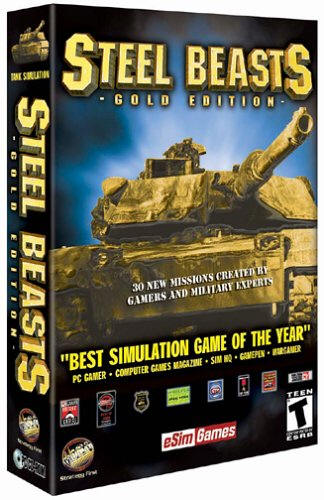
* Steel Beasts:
SB is made by a VERY SMALL company. The entire game was programmed
mainly by two guys (one full time!). Wow! For one guy, this game's
pretty darn good. Best of all, IT WORKS AND IT'S FINISHED.
But the "Army of one"
shows: no air support, no weather, no night fighting, none of many
of the features found in the other games. But what SB did was make a
playable game and add true physics. You can command a platoon of
Leopard 2A4 or M1A1s and even fire the TC's MG from an open hatch!
Troops realistically MOVE and shoot and (dis)/re-embark from APCs,
something the previous games didn't, which used symbols or cardboard
cutouts to denote infantry. The game had 3D forests of trees that
you can drive through and mow down or hide in. In previous tank sims,
there were no forests and you had to go around the few 2D trees that
were there.
But being so real, you'd
quickly find out how vulnerable tanks can be. Artillery and RPG fire
can immobilize tanks and many times I was stranded before even
encountering the enemy. Situational awareness was often pretty bad
for the US too. The enemy AI often attacked in four-five
prongs/groups and there's no way four M1A1s, two M3A2s, and four
M2A2s can defeat five huge groups of T-80s bearing down on three
objs!
Enemy AI was so great, I
often thought what Civil War General George McCellan often said, "I
need more men!" If you killed off five-out-of-six Sov dismounts from
a BMP squad and destroyed the BMP in a forest, that lone enemy
soldier would then fire his AK-47 RIGHT into your gunner's sight,
rending you blind! Hooray for him and the game's enemy AI! Boo-hoo
for you because you have to kill this lone soldier before he plinks
out something else, not to mention five T-80s bearing down on you
too...and oh, yeah, the soldier just called down artillery too so
after he took off your sights, he's running deeper into the forest!
( Have a nice day :-). That one Sov soldier deserves a medal!
Realistic, yes, but
fun...so-so. I found that with my Micro Soft Forcefeedback Pro joy
stick combo control, I had to literally track the T-80 with the
crosshairs even AFTER firing, meaning that the sabot kind of acted
like a TOW missile. In M1TP, the sabot flew so fast that once I
pushed the FIRE button, it'll fly to target...not so with SB. I also
found the COAX not that accurate compared to M1TP, and with smart
enemy AI soldiers, this could get annoying.
Another issue I have with
SB is the lack of a campaign or story. You play single battles from
a list of maps and you have to achieve objectives in each battlemap.
After you win, so what? You just get stats so SB has a "hollow" feel
to it because there is no war to win, no bragging to tell, just
survive and win the objs. I often found SB a "mission impossible"
compared to the other tank sims I've played...M1TP even on "USSR
elite" setting.
The graphics are decent
(what'd you expect from one programmer?) and there's MOUT towns,
(often "Monopoly-like" houses), to fight in. Too bad the moving
soldiers don't shoot out windows though. But you can roll over
houses and fire HEAT to set them on fire (just like M1TP). The other
tank sims often had one or two houses, not a town like SB.
Thumbs way up, and given
the choices out there, this is the tank sim that will probably work
on a new PC. Check to see if it can run on XP though. So … you can
see that many criticisms over realistic game play have been
addressed but other aspects of the sim lagged behind where M1 Tank
Platoon had advanced the state of the art.
But wait...
For a couple of years now,
there is talk of a Steel Beasts 2
from the same company which will have air
support, weather, night fighting, etc. We asked for a lot in SB2 on
their on line discussion group ...a whole laundry list...everything
from paradrops to UAVs to 18-man AAV platoons to thunder and
lightning. This talk has been going on for a long time and IMO,
it'll be ready when you see it in stores. I no longer follow up on
the talk because with one programmer, who knows when this game will
be ready. Nonetheless, my advice is to wait for an online review
before buying. SB2 is supposed to be such an advance over SB1
because the tank gameplay physics and AI is pretty solid in SB1. SB2
is meant to add the eye candy and more units. Will it work, remains
to be seen.
As far as I can see, Steel
Beasts 2 is the only realistic tank sim in development.
“ Pete “ certainly
deserves 7 / 5s coverage on the topic area. Things have come along
way and as game designers continue to exploit new technology
available to both develop and play the sims, hopefully, the market
will support their efforts. This takes us back to 1978.
As a new platoon leader in
Bad Kissingen, we were actively training for Level 1 gunnery at GTA.
The “ dry “ TCQC Course, mechanical training, crew drill and
discussion were identical to gunnery prep training as it would have
been conducted twenty years previous … with one exception. At
Ledward Barracks in Schweinfurt, they had a very recently installed
“ computerized “ gunnery simulator and in a miracle of cross Corps
cooperaton, the tankers of each Eaglehorse platoon had been allocted
a brief training window.
On the appropriate day, we
stacked the gunners and TCs into the back of a duce and made the
drive over to Schweinfurt. If you are of a certain age, you may well
recall the popular bar - then home version of “ pong “, sort of a
computer version of ping pong. I am convinced that the gunnery
trainer we used was developed by the same design team.
The device was a large TV
screen consol with a tank gunner’s Cadillac control attached to the
front. Superimposed on the screen was the M32 primary sight reticle
and parading by, ducks in a row, were a series of tank target
silhouettes. There were two variable adjustments, one increased the
speed of the duck parade, and the second created a random rocking to
the sight picture, to simulate movement over rough terrain. As I
recall, to register a “ hit “ required placing the reticle somewhat
in front of the target but, as my NCOs quickly pointed out, the
gunner’s sight picture was no where close to what was really
required to hit at GTA … or anywhere else. We arrived, we fired, we
signed off on the attendance sheet, we complained and we left.
In the modern day, at the
major troop installations, the complexity of computer based
simulation for M1 - M2 - M3 gunner training and TC / platoon leader,
platoon sergeant battle environment training is astounding in terms
of realism and ability to actually train, review performance, re -
train and then modify the scenario. Back at the meglo - mart, we
will keep patrolling the aisles and checking out the on line topic
boards for the “ next - big - tank - sim “ … one last tip, game
realism is always enhanced by eating cold chill - mac prior to
booting up!
From the Boston Globe, 8
Dec., 2004, a article that describes how civilian war games can be
modified to assist troops training for duty in Iraq. Everything
from recruiting to infantry training to the future designs of
gunner's controls has been heavily influenced by Play Station, X Box
and Nintendo. Computer based simulations are no longer just the
stuff of generals and staff officers. The digital Army seamlessly
reaches the most junior trooper with a combat MOS.
War Games 2.0
Cambridge firm designs
combat simulator to help soldiers bound for Iraq.
Hiawatha Bray
Boston Globe
8 December 2004
The driver of the supply
truck never saw the rocket propelled grenade that hit him. But his
escort, a heavily armed Humvee, spotted the insurgents almost as
soon as they opened fire. The Humvee's gunner aimed his machine gun
and fired, wiping out the bad guys with a click of his computer
mouse.
It's not Fallujah, it's
Cambridge, home of BBN Technologies, the legendary firm that helped
develop the Internet and electronic mail. Now BBN is designing
realistic combat computer games designed to help save lives of US
troops patrolling the streets of Iraq. "It's not a source of
entertainment," said Bruce Roberts, who heads up BBN's DARWARS
project. "It's serious stuff." Robert's team put together his
combat simulator in just seven months; it is already being used to
train soldiers destined for Iraq in places like Fort Lewis in
Washington State.
| |
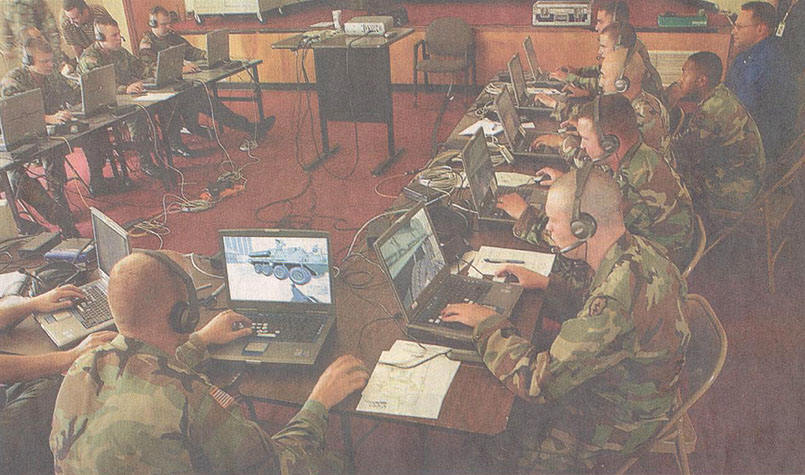 |
|
| |
Soldiers in Fort Lewis, Wash., use BBN
Technologies computer game DARWARS Ambush! in military convoy
operations training. Jason Kaye photo / Northwest Guardian / Boston
Globe |
|
DARWARS takes its
name from the Defense Advanced Research Projects Agency, the
Pentagon agency that funds unusual technologies that might
have military value. Much of BBN's early Internet research
was funded by the agency, and BBN has long been a major
recipient of agency's dollars.
The Pentagon agency
invested $1.5 million in the game project, which has so far produced
DARWARS Ambush!, a combat simulation game for training up to 24
soldiers at a time in military convoy operations. The BBN team that
produced Ambush is also working on a version to teach the skills
needed in foot patrols.
The DARWARS idea began
with Ralph Chatham, a former sonar researcher who joined the
Pentagon agency three days after the terrorist attacks of Sept. 11,
2001. Chatham had been impressed with the success of advanced
military training programs like the Army's National Training Center
at Fort Irwin, Calf. Every major unit in the Army gets this kind of
training every three years, said Chatham.
"I wanted to see if I
could create a program that allowed us to bottle that and export
it," he said.
The best way, he decided
was to capture the experience of veterans inside a computer game
that any soldier could play.
His goal"was to train the
voice in the back of the head of every solder to be aware of what
might happen of where an ambush might occur," Chatham said.
In January, Chatham got
the funding to go ahead. By March he'd settled on BBN as the best
organization to over see the effort.
"We zeroed in on the
convoy ambushes as the first place to start," said BBN's
Roberts,"because such ambushes had taken a particularly heavy toll
of American lives."
| |
 |
|
| |
BBN Technologies combat game includes
realistic looking landscapes and cities with deserts and stone
buildings like those in Iraq. images / BBN Technologies
|
|
For gaming
expertise, BBN contacted Total Immersion Software Inc., an
Alameda, Calf., company founded by Stephen Blankenship a
former police officer who later became a senior producer for
the leading game maker Electronic Arts. He founded Total
Immersion to offer his gaming expertise to the US military,
call it"a way for us to sort of contribute to national
security in a tiny way."
BBN and Total Immersion
modified an off the shelf game called Operation Flashpoint which was
created in the Czech Republic in 2001. The game was readily
available from software retailers, it could be run on any late model
PC, and it let players create their own combat scenarios.
BBN and Total Immersion
dumped the original game's Cold War scenario and created new
landscapes and cities with deserts and stone buildings like those
found in Iraq. The streets are occupied by Iraqi militiamen with AK
- 47s and women in long robes and veils, The vehicles in the game
are Army trucks and Humvees, and American troops wear desert
camouflage.
Like many popular games,
Operation Flashpoint can be played by multiple players linked over
the Internet. In the same way, DARWARS Ambush! allows soldiers to
practice either against computer generated threats or against fellow
soldiers who play as insurgents.
Robert's team combed
through after action reports of American troops in Iraq to lean the
latest deadly variations on the insurgents improvised explosive
devices or IEDs.
| |
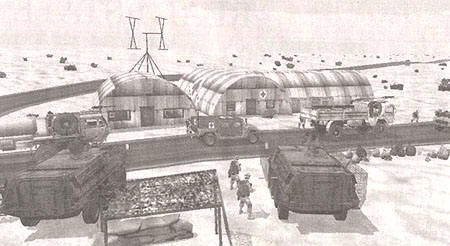 |
|
| |
Army trucks and Humvees occupy the
landscape in the DARWARS Ambush! combat game. BBN Technologies
|
|
"A unit was on a
convoy," said Roberts,"and discovered for the first time
that an insurgent had hung an IED behind a sign on the
road. Nobody had ever seen that." That bit of experience
is now imbedded in DARWARS Ambush!
So is the use of radio
controlled toy cars packed with plastic explosive. Soldiers have
also found that Iraqi rebels like to put curbside bombs right at
street corners, to catch trucks as they make tight turns. DARWARS
Ambush! plants roadside bombs the same way to teach drivers to stay
close to the middle of the road at all times.
Roberts said that new
scenarios can be continuously added and solders may be trained to
modify the software for their particular units, creating modified
versions of the game tailored to their specific challenges.
Fort Lewis, Washington,
home of the 1st Bde of the 25th Infantry Division has so far trained
about 100 soldiers using the game. Some of them are presently
deployed in Iraq. Lieutenant Colonel Tony Schmitz, chief of the
Mission Support Training Facility at Fort Lewis said it's too early
to say whether there have been any benefits. But he's impressed
with the software's potential.
"We are always looking for
new ways to train soldiers," said Schmitz. "The new generation of
soldiers who are used to playing videos, the Nintendo generation
would be comfortable with it. Plus it's cheap."
Chatham, of the Pentagon's
agency, said that time will tell whether DARWARS Ambush! can save
lives. But he says he's already seen its impact on soldiers who've
played the game.
"I know there's a captain
now who knows that he's mortal," Chatham said. I watched him
rocking back and forth in the after action review knowing he got
killed in this simulation.
Chatham hopes that the
experience will keep that captain and his soldiers alive on the
battle field. |